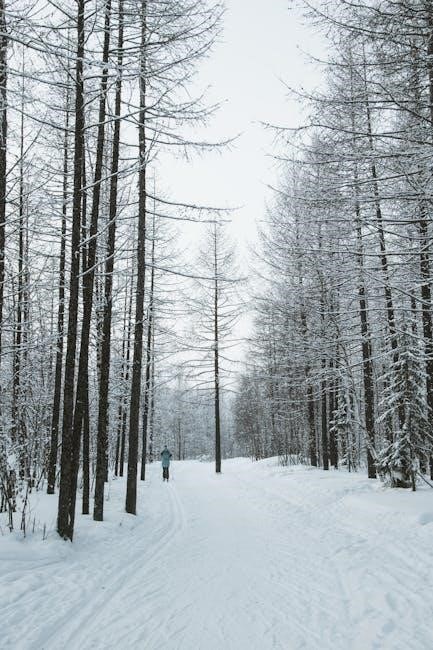Cross country skiing is a popular winter sport offering fitness, adventure, and connection with nature․ This guide helps you choose the perfect ski size for optimal performance and enjoyment․
Why Choose the Right Ski Size?
Selecting the right ski size is crucial for optimal performance, efficiency, and comfort on the trails․ Properly fitted skis ensure better control, stability, and maneuverability, allowing you to enjoy your skiing experience fully․ Ski length and width directly impact how well the skis glide and turn, making size selection a key factor in both classic and skating techniques․ A ski that is too short may lack glide, while one that is too long can be difficult to handle․ Additionally, the wrong size can lead to poor technique, increased fatigue, and reduced enjoyment․ By choosing skis tailored to your height, weight, and skiing style, you can maximize your performance and make the most of your time on the snow․ This guide will help you navigate the process with confidence․

Overview of Cross Country Skiing Styles

Cross country skiing encompasses various styles, each tailored to different techniques and terrains․ Classic skiing is the most traditional style, where skis glide in parallel tracks, emphasizing a straightforward, rhythmic motion․ Skating skiing, on the other hand, involves a more dynamic, V-shaped technique, where skis alternate edges to propel forward, offering higher speed and agility․ Both styles require specific ski designs to maximize performance․ Classic skis are typically longer and narrower, with a wax or scaled base for traction, while skating skis are shorter and wider, designed for glide and edge control․ Understanding your skiing style is essential for selecting the right equipment, as it directly impacts how the skis interact with the snow and your ability to maneuver effectively․ This guide will help you align your skiing style with the perfect ski size for your adventures․
How Height and Weight Affect Ski Length

Height and weight are critical factors in determining the ideal cross country ski length․ Your height provides a baseline for ski size, as it influences your stance and stride․ Generally, taller skiers require longer skis for better stability and glide․ However, weight plays a significant role in refining this calculation, as it affects how much pressure is applied to the skis․ Lighter skiers may find shorter skis more maneuverable, while heavier skiers might need longer skis for optimal flotation and control․ The balance between height and weight ensures the skis flex appropriately, providing the right combination of support and responsiveness․ This relationship is crucial for achieving proper technique and performance, whether you’re gliding on groomed trails or exploring backcountry terrain․ By considering both metrics, you can narrow down your ski length options effectively․

Using Height to Calculate Ski Length
Height is a fundamental factor in determining cross country ski length, as it directly impacts stride length and skiing efficiency․ A common method is to use your height in inches, multiply it by 2․6, and then subtract 5 inches to find your approximate ski length․ For example, if you’re 5’8″ (68 inches), your ski length would be around 173cm․ However, this calculation serves as a baseline and may need adjustments based on individual preferences and skiing styles․ Taller skiers often prefer longer skis for stability, while shorter skiers may opt for shorter skis for better maneuverability․ Always consider your height in relation to other factors like weight and skill level for the most accurate fit․ Refer to size charts and professional advice to refine your choice for optimal performance on the trails․
How Body Weight Influences Ski Performance
Body weight plays a crucial role in cross country ski performance, as it affects how the skis interact with the snow and respond to movement․ Lighter skiers may find shorter skis more maneuverable, while heavier skiers benefit from longer skis for better floatation and stability․ Weight distribution also impacts the ski’s camber, influencing its ability to glide and generate power․ Proper ski length ensures optimal weight transfer, allowing for efficient striding and turning․ Ignoring weight in ski selection can lead to poor performance, as skis may sink too deeply or fail to engage properly with the snow․ Balancing weight with height and skill level is essential for selecting skis that match your body and skiing style, ensuring a more enjoyable and effective experience on the trails․

Importance of Waist Width in Skis
Waist width, the narrowest part of the ski underfoot, significantly impacts performance in cross country skiing․ Narrower skis, typically 48-56mm, provide better grip and efficiency on groomed tracks, making them ideal for traditional skiing․ Wider skis, above 70mm, excel in deep snow or backcountry conditions but may not fit standard groomed tracks․ Choosing the right waist width ensures optimal glide and control, matching your skiing style and terrain․ Proper width prevents the ski from sinking too deeply or lacking necessary support, ensuring a balanced and effective skiing experience․

How Ski Shape Impacts Performance

The shape of your cross country skis, including sidecut, tip, and tail design, plays a crucial role in performance․ A narrower sidecut enhances glide efficiency on groomed trails, while a wider sidecut improves stability in deeper snow․ The tip shape also matters; a fish-scale or rounded tip can improve climbing ability in backcountry conditions․ The tail design affects maneuverability, with a rounded tail offering easier turning and a squared tail providing stability at higher speeds․ Overall, the ski’s shape must align with your skiing style and terrain preferences to ensure optimal performance, whether you’re gliding on tracks or exploring ungroomed areas․
How Skill Level Affects Ski Length
Your skill level significantly impacts the ideal length of your cross country skis․ Beginners benefit from shorter skis, typically within 5-10 cm below their height, as they are easier to maneuver and control․ Intermediate skiers often prefer skis closer to their height, providing a balance between stability and agility․ Advanced skiers may opt for longer skis, enhancing glide efficiency and speed, especially in racing or longer-distance skiing․ Skill level influences both confidence and performance, so selecting the right ski length ensures a more enjoyable and effective skiing experience tailored to your abilities and goals․
Choosing Skis for Different Terrain
The type of terrain you primarily ski on plays a crucial role in selecting the right skis․ For groomed tracks, narrower skis with a waist width of 48-56mm are ideal, as they provide speed and efficiency․ Wider skis, typically above 70mm, are better suited for deep snow and backcountry skiing, offering superior float and stability․ If you ski in varied conditions, consider an all-around ski with a moderate waist width that balances performance across different terrains․ The ski’s shape and camber also matter, with skating skis being narrower and more rigid, while backcountry skis feature a wider, more forgiving design․ Choosing skis tailored to your most common skiing environment ensures optimal performance, comfort, and enjoyment on the trails․
Understanding Mondo Boot Sizing
Mondo boot sizing is a standardized system used to ensure a precise fit between your boots and skis․ Unlike traditional shoe sizes, Mondo sizing is based on the actual centimeter measurement of your foot, providing a more accurate fit․ To determine your Mondo size, measure the length of your foot in centimeters and match it to the corresponding size on a Mondo chart․ This system is crucial for cross country skiing, as proper boot fit affects performance, comfort, and control․ By using Mondo sizing, you can ensure compatibility with ski bindings and avoid issues like poor alignment or movement within the boot․ This consistency across brands simplifies the process of finding the right gear, making it easier to enjoy your skiing experience․

Ensuring Proper Boot and Ski Fit
A proper boot and ski fit is essential for optimal performance and comfort in cross country skiing․ Start by ensuring your boots fit snugly, with enough room for toes to wiggle but not so loose that they slide during movement․ Use the Mondo sizing chart to match your boot size accurately․ Next, check the compatibility of your boots with the ski bindings, as improper alignment can affect control and efficiency․ Test the fit by clicking the boots into the bindings and ensuring a smooth, secure attachment․ Additionally, consider the overall balance of the system—boot stiffness, ski flex, and pole length should harmonize with your skiing style and ability level․ A well-fitted setup enhances stability, power transfer, and maneuverability, allowing you to enjoy a more enjoyable and effective skiing experience․ Proper fit also reduces the risk of discomfort or injury, making every outing more pleasant․ By prioritizing a precise fit, you can maximize your skiing potential and fully immerse yourself in the sport․
Why Generic Size Charts Can Be Misleading

Generic size charts can be misleading as they often fail to account for individual variations and specific ski designs․ While they provide a general starting point, factors like body weight, skiing style, and intended terrain significantly influence the ideal ski length and width․ Different brands may use varying sizing standards, leading to inconsistencies․ For instance, one brand’s medium length might be another’s large․ Additionally, skis designed for racing versus touring have different performance characteristics that sizing charts don’t typically address․ Relying solely on a generic chart may result in skis that are too long or too short, affecting control and efficiency․ It’s crucial to consider personal preferences and consult with experts or detailed guides tailored to specific needs for an accurate fit․ This ensures a more enjoyable and effective skiing experience․ Proper sizing enhances performance and comfort, making it worth the extra effort to get right․
Understanding Ski Sizing Variability Across Brands
Different cross country ski brands often have varying sizing standards, making it challenging to find a universal fit․ Each brand tailors its skis to specific skiing styles, terrains, and performance goals, leading to discrepancies in length and width recommendations․ For example, one brand’s medium-length ski might be shorter or longer than another’s, even for the same user height and weight․ This variability is further complicated by differences in ski design, such as sidecut, waist width, and flex patterns․ Additionally, some brands cater to racers, while others focus on recreational or backcountry skiers, affecting sizing priorities․ To navigate this, it’s essential to consult brand-specific size charts and consider expert recommendations․ Understanding these differences ensures you select skis that align with your needs, enhancing both performance and comfort on the trails․ Always verify sizing details for your specific brand and model to avoid mismatches․
Final Tips for Choosing the Perfect Skis
Selecting the right cross country skis involves balancing multiple factors․ Consider your skiing style, whether it’s classic, skating, or backcountry, as each requires specific ski designs․ Your height, weight, and skill level are crucial for determining length and flex․ Terrain also plays a role; narrower skis are better for groomed trails, while wider skis excel in deep snow․ Don’t rely solely on generic size charts, as brands vary in sizing standards․ Test skis if possible and seek advice from experts or online reviews․ Proper boot and pole compatibility is equally important for optimal performance․ Finally, prioritize your skiing goals—whether speed, stability, or versatility—to make an informed decision․ By carefully evaluating these elements, you’ll find skis that enhance your experience and keep you enjoying the trails all season long․ Remember, the right fit ensures comfort and efficiency, making every ski session more enjoyable․ Always double-check specifications and consider future skiing aspirations when making your choice․ This thoughtful approach guarantees a perfect match for your cross country skiing adventures․